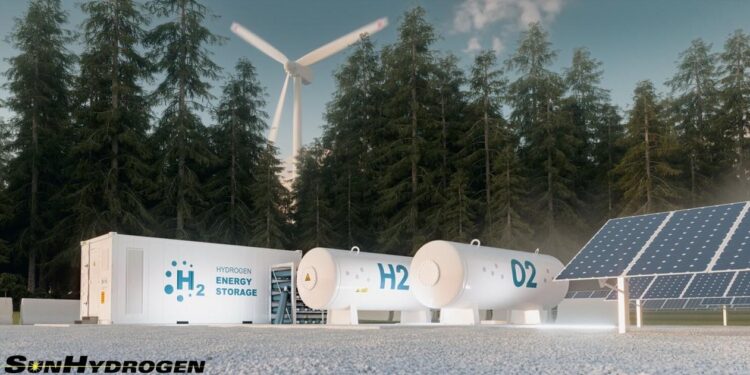In a significant stride toward a cleaner energy future, SunHydrogen has unveiled its latest innovation-a large-scale hydrogen reactor-right in the heart of Houston. This breakthrough technology promises to transform the way we produce green hydrogen, harnessing the power of sunlight to generate a sustainable fuel source. As the world intensifies its search for carbon-free energy solutions, SunHydrogen’s new facility marks an exciting chapter in the pursuit of scalable, renewable hydrogen production.
SunHydrogen’s Breakthrough in Scalable Hydrogen Production Expanding Clean Energy Horizons
SunHydrogen’s latest innovation marks a pivotal moment in the quest for sustainable energy solutions. The newly unveiled large-scale hydrogen reactor in Houston leverages proprietary nanotechnology to split water molecules using sunlight, producing hydrogen on a remarkably efficient and environmentally friendly scale. This advancement addresses one of the biggest challenges in clean energy: scalable, cost-effective hydrogen production. By integrating sunlight directly into the production process, the system drastically reduces reliance on fossil fuels and curbs greenhouse gas emissions, driving significant progress toward a carbon-neutral future.
Key features of the Houston reactor include:
- Modular design enabling rapid deployment and scalability
- High solar-to-hydrogen conversion efficiency exceeding traditional electrolysis methods
- Durability with materials engineered for long-term outdoor operation
- Low operational costs by harnessing abundant sunlight and water
Below is a brief comparison highlighting the reactor’s advantages versus conventional techniques:
| Parameter | SunHydrogen Reactor | Traditional Electrolysis |
|---|---|---|
| Energy Source | Solar directly | Electric grid (often fossil-based) |
| Conversion Efficiency | 20%+ | 10-15% |
| Scalability | Modular & flexible | Large, fixed facilities |
| CO2 Emissions | Negligible | Variable, often significant |
Analyzing the Technical Innovations Behind the Houston Reactor and Their Environmental Impact
The Houston reactor employs a range of groundbreaking technologies, setting it apart from conventional hydrogen production systems. At its core, SunHydrogen has integrated photocatalytic nanoparticles that harness solar energy directly to split water molecules. This process significantly reduces energy input, relying primarily on abundant sunlight instead of fossil fuels. Moreover, the reactor’s modular design allows for scalable deployment, optimizing production capacity while minimizing operational footprint. Key innovations include:
- Advanced semiconductor materials that increase sunlight absorption efficiency
- Self-repairing catalytic surfaces to enhance durability and reduce maintenance
- Integration with local grid for energy balancing and storage solutions
Environmentally, these features translate into a profound reduction in carbon emissions compared to traditional hydrogen production methods. By leveraging renewable energy inputs and eliminating the use of toxic catalysts, the Houston reactor represents a cleaner alternative fostering sustainable fuel development. The table below illustrates a side-by-side comparison of key environmental metrics between this new reactor and conventional steam methane reforming (SMR) techniques:
| Metric | Houston Reactor | Steam Methane Reforming |
|---|---|---|
| Carbon Emissions | ~0 kg CO₂ per kg H₂ | 9-12 kg CO₂ per kg H₂ |
| Energy Source | Solar (renewable) | Natural Gas (fossil fuel) |
| Water Usage | Minimal, recycled within system | High, requires continuous input |
| Operational Waste | Negligible | Significant, including CO₂ and other pollutants |
Strategic Recommendations for Integrating Large-Scale Hydrogen Solutions into Existing Energy Infrastructure
To maximize the impact of large-scale hydrogen deployment, operators must prioritize a phased approach that harmonizes with current energy systems. This involves leveraging existing natural gas pipelines for hydrogen blending, retrofitting power plants with hydrogen-compatible turbines, and enhancing grid flexibility to accommodate variable renewable inputs. Key strategies include:
- Implementing advanced sensors and monitoring systems for safe hydrogen integration
- Establishing strong partnerships between public and private sectors to secure funding and policy support
- Promoting workforce training programs to develop specialized skills in hydrogen technology operation and maintenance
Creating a resilient and adaptive framework is essential to address potential challenges such as infrastructure degradation or fluctuating supply-demand dynamics. Below is a summarized approach that balances innovation with practicality:
| Focus Area | Strategic Action | Expected Outcome |
|---|---|---|
| Infrastructure | Upgrade pipelines and storage for hydrogen compatibility | Safe, reliable transport and storage |
| Policy | Incentivize hydrogen blending and production | Accelerated market adoption |
| Technology | Develop modular reactors and scalable electrolyzers | Flexible and cost-effective energy generation |
To Wrap It Up
As SunHydrogen’s large-scale hydrogen reactor begins its journey in Houston, the horizon of clean energy glimmers with renewed promise. This advancement not only underscores the potential of innovative hydrogen technologies but also marks a pivotal step toward a more sustainable future. While challenges remain, the unveiling of this reactor serves as a tangible beacon, illuminating the path ahead for hydrogen’s role in transforming the global energy landscape. As we watch this story unfold, one thing is clear: the quest for greener fuel solutions is gathering momentum, powered by ingenuity and driven by the urgent need for change.































